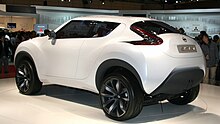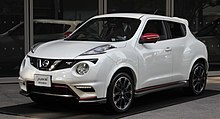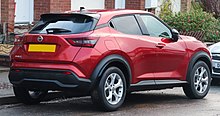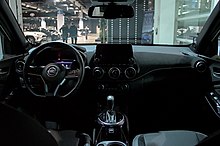The Nissan Juke (Japanese: 日産・ジューク, Hepburn: Nissan Jūku) is a subcompact crossover SUV (B-segment) produced by the Japanese car manufacturer Nissan since 2010. Debuted as a production vehicle at the 2010 Geneva Motor Show in March, it was introduced to North America at the 2010 New York International Auto Show to be sold for the 2011 model year, and it currently slots below the compact Qashqai.
| Nissan Juke | |
|---|---|
 Nissan Juke (F16) | |
| Overview | |
| Manufacturer | Nissan |
| Production | 2010–present |
| Body and chassis | |
| Class | Subcompact crossover SUV (B) |
| Body style | 5-door SUV |
| Layout | Front-engine, front-wheel-drive Front-engine, all-wheel-drive (2010–2019) |
The second-generation model was revealed for the European market in September 2019, offering larger dimensions by utilising the newer Renault–Nissan CMF-B platform.[1] The second generation marks the withdrawal of the model from most markets outside Europe and Australasia to make way for the Nissan Kicks.[2][3][4]
The name "juke" means to "dance or change directions demonstrating agility", and is also derived from the word "jukebox".[5]
First generation (F15; 2010)
| First generation | |
|---|---|
 | |
| Overview | |
| Model code | F15 |
| Also called | Infiniti ESQ (China) |
| Production | June 2010 – 2019 |
| Model years | 2011–2017 (North America)[6] |
| Assembly |
|
| Designer | Matthew Weaver[7] Kenji Kawasaki (pre-facelift Juke Nismo)[8] |
| Body and chassis | |
| Layout | Front-engine, front-wheel-drive Front-engine, all-wheel-drive |
| Platform | Nissan B platform |
| Related | Nissan Micra (K13) Nissan Note (E12) Nissan Cube Renault Captur Nissan GT-R (for Juke-R only) |
| Powertrain | |
| Engine | |
| Transmission | 5-speed manual 6-speed manual Xtronic CVT 6-speed dual-clutch automatic (Juke-R) |
| Dimensions | |
| Wheelbase | 2,530 mm (99.6 in) |
| Length | 4,125–4,135 mm (162.4–162.8 in) |
| Width | 1,765 mm (69.5 in) |
| Height | 1,565–1,570 mm (61.6–61.8 in) |
| Curb weight | 1,321–1,456 kg (2,912–3,210 lb) |
| Chronology | |
| Predecessor | Nissan Dualis (Japan) |
| Successor | Nissan Kicks (Americas & Asia) |
On 11 February 2009, Nissan announced that the model would go into production at the Nissan Motor Manufacturing UK (NMUK) plant in Sunderland, United Kingdom, during 2010 following its appearance as the Nissan Qazana concept car at the 2009 Geneva Motor Show.[9]
- Nissan Qazana (front view)
- Nissan Qazana (rear view)
The Juke was designed at Nissan Design Europe in London and refined at Nissan's Design Centre in Japan. It is based on the Nissan B platform.[10] The Sunderland plant (NMUK) manufactures for the European market, Australia and New Zealand, while Nissan's facility in Oppama, Japan, produces the vehicle for all other countries. Both Sunderland and Oppama are suppliers of the all-wheel drive variant. The Purwakarta plant (NMI) in Indonesia assembled the Juke for the domestic market and Thailand with a local content of 40 percent, front-wheel-drive only.[11]
A rebadged version of the first-generation Juke was sold in China as the Infiniti ESQ.[12]
Design
The car's profile is dominated by the prominent wheel arches and the body's high waistline which contrast with the slim side windows, which is a modern interpretation of "coke bottle styling" popular during the 1960s and 1970s. Echoing a style first seen Nissan's high performance electric coupé concept shown at the 2007 Frankfurt Motor Show, the glasshouse resembles a racing helmet visor. A coupé-like appearance is achieved by the rear door handles being located near the C-pillars, within the window frame. Locating the rear door handles within the window frame is a Nissan styling tradition, begun with the 1985 Nissan Pathfinder. The sport motif continues inside with the red or grey-painted centre console bearing similarity to a motorcycle fuel tank.
The front end features a stacked array of lights. Running lamps and indicators are mounted atop the front wings, their lenses visible from inside the cabin as an aid to maneuvering. Below them, under the lower edges of an expansive, curved grille, the main headlamps are intended to be reminiscent of those fitted to rally cars during the 1960s and 1970s. Where fitted, fog lamps are situated on a third level within the sump guard at the bottom.
- 2013 Nissan Juke Tekna 1.6 (rear view)
- Interior
Cabin
The Juke features seating for five (two in front, three in back). The rear seats have a 60/40 split and can be folded down independently in order to carry larger objects. The rear cargo area is small but features additional storage beneath the floor (front wheel drive models only).[citation needed]
The steering column instrumentation cluster features a tachometer, speedometer, and a small display between them that displays real-time fuel efficiency, odometer and trip odometer.
The center portion of the dash contains the radio and the I-CON control (if equipped). Depending on market and trim level the Juke may be equipped with iPod or USB connectivity, NissanConnect GPS navigation, rear-view camera and Bluetooth audio. A relatively deep glovebox on the passenger side houses an iPod connector (if equipped).
All but base models are equipped with Nissan's Integrated Control System, dubbed I-CON: a command module that sits in the lower dashboard, which manages both the climate control and the vehicle's drive mode (Normal, Sport or Eco). Its display and nomenclature change according to the function selected.[13] Among the available display data are fuel efficiency stats, real-time G-force measurements and turbo boost pressure.
Markets
Japan
In Japan, where the car was launched on 9 June 2010, orders totalled 10,943 units in its first month, surpassing Nissan's monthly target of 1,300. By 5 October 2010, Japanese sales had increased to 20,000 while European and US figures also exceeded expectations with orders for 30,000 and 17,500 cars taken for the respective markets. Four levels are specified. The RX and RS models are equipped with the HR15DE I4 engine, while the MR16DDT was supplied for the 16GT and 16GT FOUR.
United States and Canada
Three trim levels were initially available in the US with the 1.6-litre turbocharged MR16DDT petrol engine: S, SV and SL. The base engine is rated at 188 hp (140 kW) at 5,600 rpm and 177 lb⋅ft (240 N⋅m) of torque at 2,000 rpm. The base S model was available only with a CVT and lacks the I-CON display. The SV model adds I-CON, optional 6-speed manual transmission and moonroof. The SL model adds leather seats, USB connectivity and a rear-view camera. All-wheel drive with torque vectoring was optional on all trims but cannot be paired with a manual transmission.
After the 2017 model year, the Juke was discontinued in the United States and in Canada.
Europe
The car was launched in the UK, were it was manufactured, on 24 September 2010.[citation needed]
Five trim levels are indicated for the 1.6-litre HR16DE petrol, 1.5-litre K9K diesel and 1.6-litre MR16DDT petrol engines: Visia, Acenta (also available with Sport and Premium packs), Tekna, Nismo and Nismo RS. In 2012, Nissan replaced the limited edition Juke Kuru with the Juke Shiro model. The Shiro was a limited edition Juke with white accents throughout the interior including white stitching on the leather seats, gear shifter and steering wheel as well as several other aesthetic options.[citation needed]
Indonesia
Locally assembled by Nissan Motor Indonesia (NMI), the Juke for the Indonesian market comes with two trim levels: RX and Red, with one engine option, the 1.5-litre HR15DE inline-four. Both trims are only available with a CVT. The Red model, only available in Indonesia, adds roof spoiler, different grille colour and bigger audio display screen. On 12 February 2015, Nissan Motor Indonesia added "Revolt" trim to the lineup, while introducing facelift for Indonesian Juke. Between 2014 and 2017, the locally assembled Juke was exported to Thailand.[14] Production ceased in September 2018.[15]
Facelift
At the 2014 Geneva Motor Show, Nissan unveiled the revised Nissan Juke for 2015 model year, which went on sale in the summer of 2014.[16] On the exterior, the revision has new L-Shaped LED Daytime Running and Indicator clusters, new front and rear bumper styling and new colour options. New standard equipment includes a rear-view camera, keyless entry and Bluetooth hands-free phone system.
- 2018 Nissan Juke (UK; facelift)
- 2018 Nissan Juke (UK; facelift)
Juke Nismo
New for 2013, the NISMO version differs from the base Juke in styling changes to the bumpers and side skirts, interior styling, modified suspension and steering, 18 in (46 cm) wheels, an unspecified "torque vectoring" option, and engine tuning. The engine is rated at 197 hp (147 kW) at 6,000 rpm and 184 lb⋅ft (249 N⋅m) of torque at 2,000 rpm.[17] There was also a higher-end Nismo RS variant available, with upgraded standard equipment (Recaro front seats, carbon fiber). The engine is upgraded to 215 hp (160 kW) at 6,300 rpm and 210 lb⋅ft (285 N⋅m) at 3,600 rpm.
The New York Times review was generally positive, but: "About that styling: I love it, but you might hate it. The face is dominated by bug-eye headlamps, and the running lights bulge up above the hood such that they’re in the driver’s line of sight. At night, the effect is of large bio-luminescent slugs lounging atop the front fenders. Admittedly, it’s more appealing than I’m making it sound."[18]
- Nissan Juke 1.6 DIG-T Nismo (pre-facelift)
- Nissan Juke 1.6 DIG-T Nismo (pre-facelift)
- 2018 Nissan Juke Nismo RS (facelift)
Juke-R

The Juke-R is a limited production run Juke with the drivetrain, chassis, and the 3.8-litre VR engine from the Nissan GT-R that produces 545 hp (406 kW).[19] The car was developed after hours by a group of Nissan engineers and motorsport engineering company RML Group (a Nissan partner); the production was handled by tuners Severn Valley Motorsport.[20] Although Nissan planned to produce 17 or 23 units,[21][22] only a total of five Juke-Rs were produced.[20] Two of those five were kept by Nissan, meaning only three examples were actually sold.[20]
Infiniti ESQ
Beginning in 2014, the Juke has been sold in China as the Infiniti ESQ. Debuted at 2014 Chengdu Auto Show, it is based on the pre-facelift Juke Nismo with its upgraded suspension, aero enhancements and 18-inch wheels. It uses the turbocharged 1.6-liter four-cylinder engine with 147 kW (200 PS; 197 hp).[23]
As of 2016, the ESQ is the only Infiniti model not to have a name beginning with the letter Q.
- 2014 Infiniti ESQ
- 2014 Infiniti ESQ
Specifications
| 1.6 | 1.6 | 1.6 DIG-T | 1.6 DIG-T (Nismo) | 1.5 dCi DPF | |
|---|---|---|---|---|---|
| In Production Since | 02/2013 | 10/2010 | 10/2010 | 03/2013 | 10/2010 |
| Engine Type | Inline-4 | Inline-4, Turbocharged | Inline-4 Turbodiesel, Common rail | ||
| Displacement | 1598 cc | 1618 cc | 1461 cc | ||
| Power | 69 kW (94 PS; 93 hp) @ 5400 rpm | 86 kW (117 PS; 115 hp) @ 6000 rpm | 140 kW (190 PS; 188 hp) @ 5600 rpm | 147 kW (200 PS; 197 hp) @ 6000 rpm | 81 kW (110 PS; 109 hp) @ 4000 rpm |
| Torque | 140 N⋅m (103 lbf⋅ft) @ 3200-4400 rpm | 157 N⋅m (116 lbf⋅ft) @ 4000 rpm | 240 N⋅m (177 lbf⋅ft) @ 2000-5600 rpm | 250 N⋅m (184 lbf⋅ft) @ 2000-4800 rpm | 240 N⋅m (177 lbf⋅ft) @ 1750 rpm |
| Standard Drivetrain | Front-wheel drive | ||||
| Optional Drivetrain | — | All-wheel drive | — | ||
| Standard Transmission | 5-Speed Manual | 6-Speed Manual | |||
| Optional Transmission | — | Xtronic CVT | — | ||
| Weight | 1,195–1,225 kg (2,635–2,701 lb) | 1,215–1,272 kg (2,679–2,804 lb) or 1,217–1,290 kg (2,683–2,844 lb)[a] | 1,325–1,350 kg (2,921–2,976 lb) or 1,455–1,475 kg (3,208–3,252 lb)[b] | 1,320–1,360 kg (2,910–3,000 lb) | |
| Maximum Payload | 420–450 kg (930–990 lb) | 380–458 kg (838–1,010 lb) | 385–410 kg (849–904 lb) | 385–410 kg (849–904 lb) | 390–430 kg (860–950 lb) |
| 0–100 km/h (0–62 mph) | 12.0 s | 11.1 s 11.5 s[a] | 8.2 s 8.8 s[b] | 7.8 s 8.2 s[b] | 11.2 s |
| Top Speed | 168 km/h (104 mph) | 178 km/h (111 mph) 170 km/h (110 mph)[a] | 215 km/h (134 mph) 200 km/h (120 mph)[b] | 175 km/h (109 mph) | |
| Fuel Consumption (Combined) | 6.0 L/100 km (39 mpg‑US) | 6.0 L/100 km (39 mpg‑US) 6.3 L/100 km (37 mpg‑US)[a] | 6.9 L/100 km (34 mpg‑US) 7.4 L/100 km (32 mpg‑US)[b] | 4.8 L/100 km (49 mpg‑US) | |
| CO2-Emission, combined | 138 g/km | 139 g/km 145 g/km[a] | 159 g/km 175 g/km[b] | 159-169 g/km 175 g/km[b] | 124 g/km |
| Euro Emissions Classification | Euro 5 | ||||
Marketing
In August 2013, Nissan launched a commercial for the Juke, featuring Stormtroopers from the Star Wars series.[24]
Second generation (F16; 2019)
| Second generation | |
|---|---|
 | |
| Overview | |
| Model code | F16 |
| Production | 2019–present |
| Assembly | United Kingdom: Sunderland (NMUK) |
| Designer | Koji Wakabayashi, Takashi Utsunomiya and Marten Wallgren[25] |
| Body and chassis | |
| Layout | Front-engine, front-wheel-drive |
| Platform | Renault–Nissan CMF-B HS platform[26] |
| Related | Renault Captur II Renault Clio V |
| Powertrain | |
| Engine | |
| Electric motor | Permanent magnet synchronous motor (hybrid) |
| Power output |
|
| Transmission | 6-speed manual 7-speed dual-clutch automatic eCVT |
| Hybrid drivetrain | Power-split (hybrid) |
| Battery | 1.2 kWh lithium-ion (hybrid) |
| Dimensions | |
| Wheelbase | 2,636 mm (103.8 in) |
| Length | 4,210 mm (165.7 in) |
| Width | 1,800 mm (70.9 in) |
| Height | 1,595 mm (62.8 in) |
The second-generation Juke was unveiled on 3 September 2019 in London, Paris, Milan, Barcelona and Cologne.[27] It went in production in October 2019. Nissan continued to build the Juke at its plant in Sunderland, UK. Customer deliveries begun in late November in European markets.[28]
The vehicle is larger and based on an all-new CMF-B platform shared with the second-generation Renault Captur and the fifth-generation Renault Clio. The new platform makes extensive use of high-strength steel which is claimed to offer better stability, performance, and cornering capabilities. Despite that, the second-generation Juke is lighter by around 23 kg (51 lb) compared to the previous-generation model.[29]
Nissan claims rear-seat knee room is increased by 58 mm (2.3 in), rear head room by 11 mm (0.4 in), and the boot capacity is now 20 percent bigger at 422 L (14.9 cu ft) because of its larger size. The new Juke adopts an all-new dashboard layout with a 'floating' central display, a new multifunction steering wheel, and a reduced number of buttons on the center console.[29]
Initial engine option is the 1.0-litre three-cylinder DIG-T turbocharged petrol engine which produces 117 PS (115 hp; 86 kW) and 180 N⋅m (18.4 kg⋅m; 133 lb⋅ft).[30] In March 2022, a 1.6-litre petrol hybrid engine option from the Renault Captur was introduced alongside the 2022 improved model.[31]
For most markets outside Europe and Australasia, the second-generation Juke was never introduced as it was replaced by the V platform-based Kicks. The Kicks was revealed in North America in 2017 for 2018 model year, directly replacing the Juke.[32] The Juke was also phased out in Japan and several Southeast Asian markets in favour of the Kicks e-Power.[33][34]
The second-generation Juke was released in Australia in May 2020, with four trim levels available.[35] It was also launched in Taiwan in November 2020, and sold alongside the locally assembled Kicks.[36][37]
- Rear view
- Interior
- 2023 Juke Hybrid (Europe)
Safety
The second-generation Juke was awarded a full five-star rating by Euro NCAP.[38]
Reception
It was reported that customers of the Juke mainly consisted of young buyers and the elderly, resulting in an average age in the late 40s.[39]
In Europe, it is Nissan's second best-selling car behind the Qashqai. U.S. sales of the Juke slowed in 2015, but the crossover sold 38,000 units in 2013 and 2014, and about 36,000 in 2011 and 2012.[40]
Awards and recognition
- The Nissan Juke received Insurance Institute for Highway Safety (IIHS) Top Safety Pick in 2011.[41]
- A Nissan Juke driven by stunt-driver Terry Grant claimed a Guinness World Record when it was driven around the Goodwood Hill Course on two wheels for 2 minutes and 55 seconds.[42]
- The Nissan Juke received The Grand Tour's 2017 "Nissan Juke Award" for the worst car of the year.[43]
Sales
| Year | Japan[44] | Europe[i][45][46] | U.S. | Canada[47] | Indonesia[48] | Thailand |
|---|---|---|---|---|---|---|
| 2010 | 22,803 | 22,228 | 8,639[49] | 825 | ||
| 2011 | 34,224 | 101,147 | 35,886[49] | 4,586 | 9,573 | |
| 2012 | 33,648 | 101,440 | 36,358[50] | 3,738 | 6,564 | |
| 2013 | 18,727 | 106,411 | 38,157[50] | 4,077 | 3,128 | |
| 2014 | 14,444 | 97,538 | 38,184[51] | 3,641 | 1,100 | 10,236[52] |
| 2015 | 9,622 | 102,574 | 27,121[51] | 4,473 | 850 | 2,250[53] |
| 2016 | 8,645 | 98,108 | 19,577[54] | 4,442 | 305 | 1,096[55] |
| 2017 | 5,091 | 91,744 | 10,157[54] | 1,900 | 229 | 882[56] |
| 2018 | 4,043 | 68,773 | 731[57] | 146 | ||
| 2019 | 3,052 | 47,519 | 11[58] | 75 | ||
| 2020 | 425 | 58,402 | 5 | |||
| 2021 | 62,535 | |||||
| 2022 | 45,710 |
References
External links














